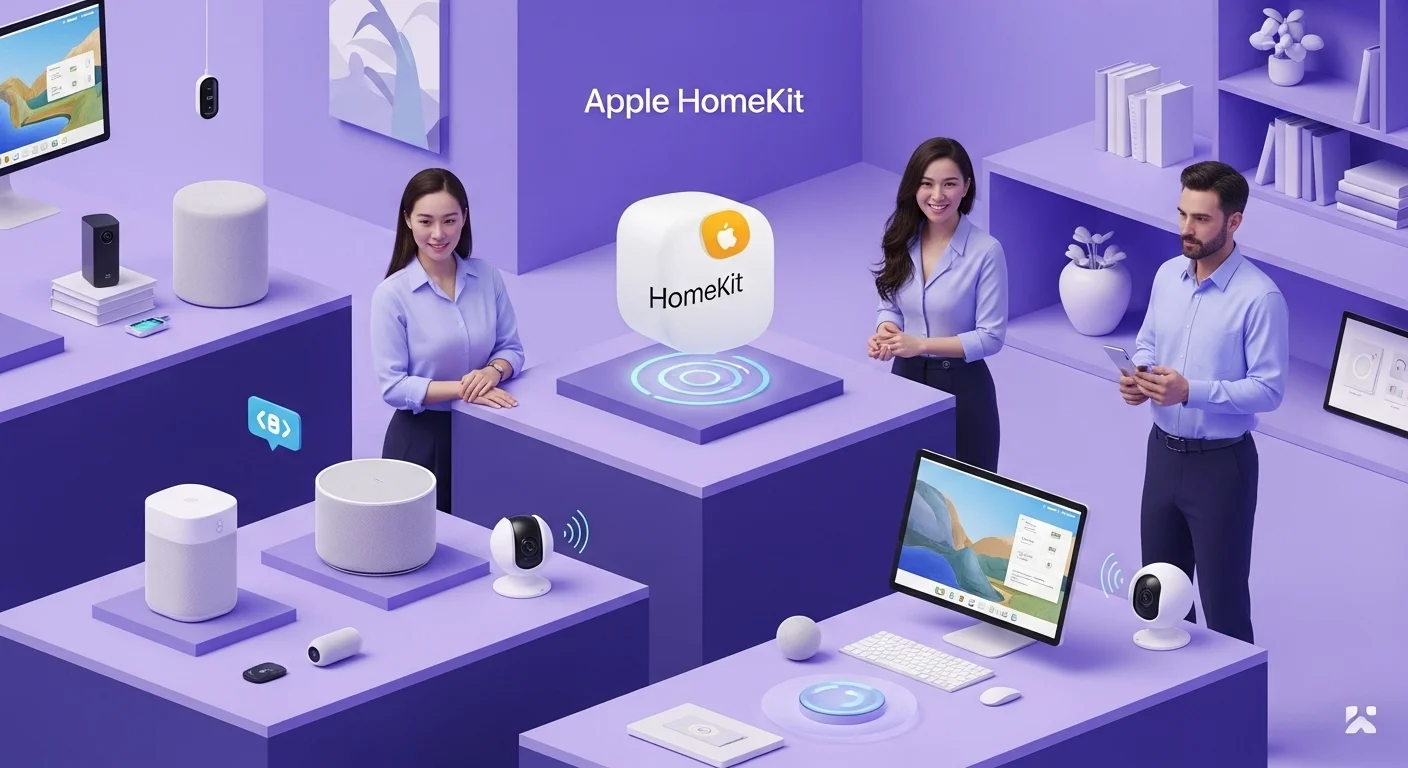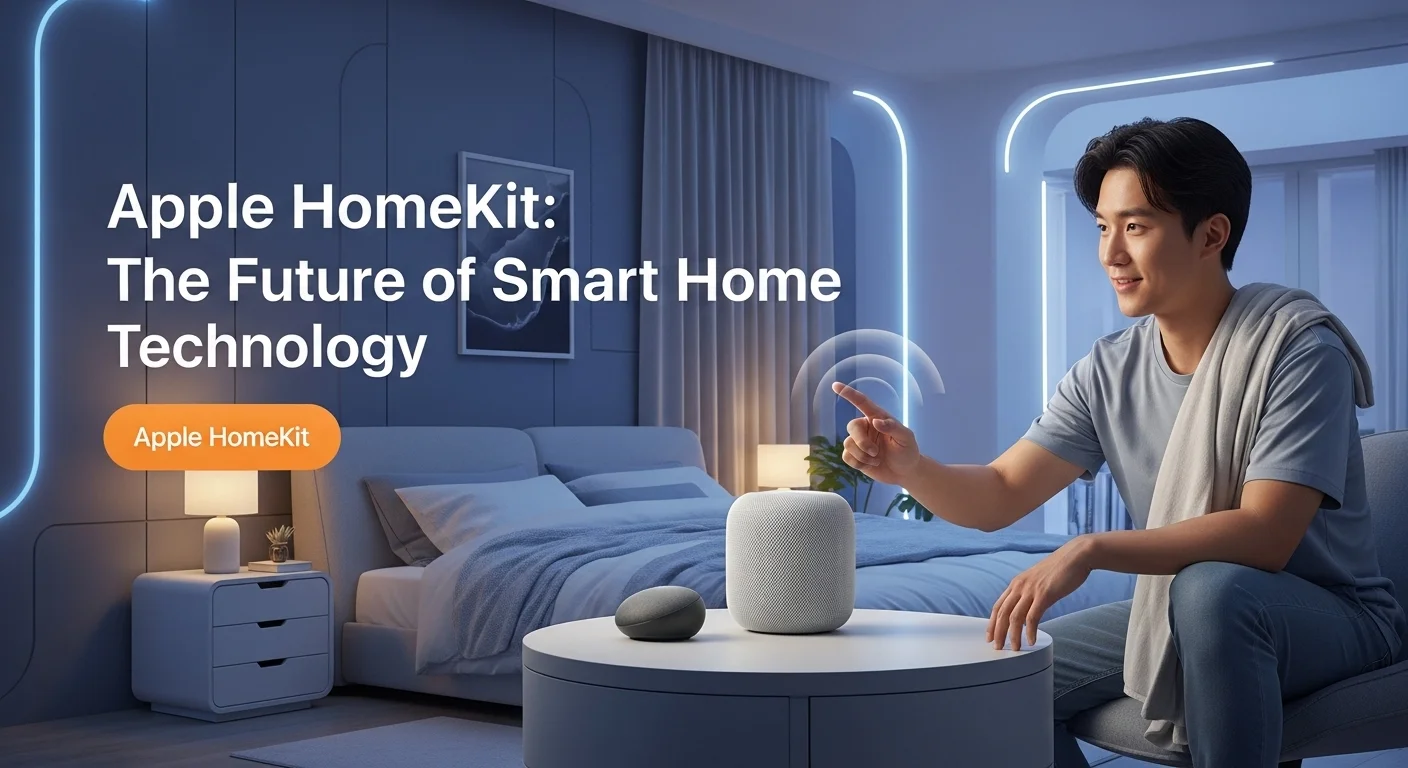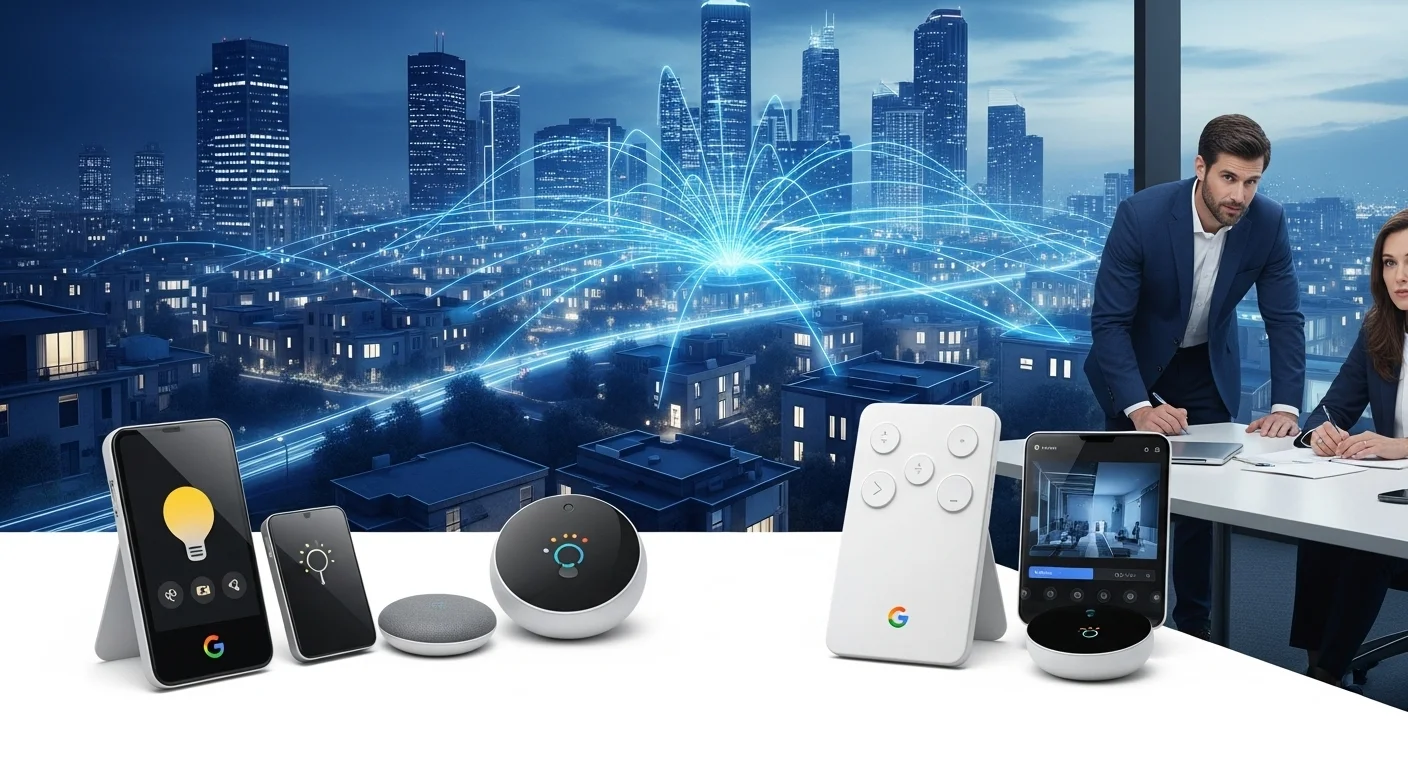Apple Homekit: The Future of Smart Home Technology

Executive Summary
Apple HomeKit represents a pivotal shift in smart home technology, offering a secure, private, and seamlessly integrated framework for controlling a vast ecosystem of connected devices. For businesses and tech enthusiasts, HomeKit is more than just convenience; it's a robust platform for creating intelligent environments. Its importance in technology stems from its core principles: end-to-end encryption, local processing, and a user-centric approach that sets it apart from competitors. This article delves into the architecture of HomeKit, exploring its business applications in small offices, hospitality, and real estate, where it can enhance efficiency, security, and user experience. We will cover the expansive world of products compatible with Apple HomeKit, from sophisticated lighting to advanced security systems. Furthermore, we will explore the exciting realm of Apple HomeKit DIY, empowering users to extend the ecosystem's capabilities through platforms like Homebridge and Home Assistant. This comprehensive overview will demonstrate how Apple HomeKit integration and sophisticated features like Apple HomeKit lighting control are not just shaping the future of our homes, but also providing powerful tools for modern businesses and technology pioneers.
Table of Contents
What is Apple Homekit and why is it important in Technology?
In the ever-evolving landscape of the Internet of Things (IoT) and smart home technology, Apple HomeKit stands out as a formidable and sophisticated framework. It's not merely an application or a single product, but a comprehensive ecosystem designed by Apple to unify and simplify the control of smart home accessories. Its importance in the broader technology sector cannot be overstated, as it champions principles of security, privacy, and user experience that are setting new industry standards. For businesses and technology enthusiasts alike, understanding HomeKit is crucial for harnessing the power of intelligent automation, whether in a residential setting or a commercial enterprise.
At its core, Apple HomeKit is a software framework built into iOS, iPadOS, macOS, watchOS, and tvOS. [19] This deep integration across Apple's entire hardware lineup is its foundational strength. It provides a standardized communication protocol that allows disparate smart devices—from light bulbs and thermostats to door locks and security cameras—to speak a common language. [38] This eliminates the fragmented experience of juggling multiple manufacturer-specific apps, consolidating control into a single, intuitive interface: the Apple Home app. [46] The importance of this unification is profound. It lowers the barrier to entry for consumers, making the smart home more accessible, and provides a stable, predictable platform for developers and manufacturers to build upon.
The Three Pillars of HomeKit: Security, Privacy, and Simplicity
To truly grasp HomeKit's significance, one must look at its three guiding principles. First and foremost is security. In an age where data breaches are commonplace and the security of IoT devices is a major concern, Apple has engineered HomeKit with a security-first approach. All communication between an Apple device (like an iPhone), a home hub (an Apple TV or HomePod), and a HomeKit accessory is end-to-end encrypted. [24] This includes communications over the local network and remotely. Furthermore, Apple's stringent MFi (Made for iPhone/iPad) certification program requires hardware manufacturers to include a special authentication coprocessor in their devices, ensuring that only approved and vetted products can join a HomeKit network. This robust security model is a key differentiator from other platforms and is particularly vital for business applications where sensitive data and physical security are paramount.
The second pillar is privacy. Apple's business model is centered on selling hardware and services, not user data. This philosophy extends directly to HomeKit. All data related to your home, such as automation schedules, device status, and camera recordings, is processed locally on your devices and home hub whenever possible. When remote access is needed, the data is encrypted and transmitted through Apple's servers, but Apple itself cannot decrypt or read it. A prime example of this is HomeKit Secure Video, where video analysis (like detecting people, pets, or vehicles) happens on your local home hub, not in the cloud. [19] Only after this local analysis are the encrypted recordings stored in the user's iCloud account. This commitment to privacy builds trust, a critical component for both individual users and businesses considering smart technology adoption.
The third pillar is simplicity. From the initial setup process—often as simple as scanning a QR-like code—to daily control via the Home app or Siri, the user experience is designed to be seamless and intuitive. Users can organize devices by rooms, create powerful 'Scenes' that control multiple devices with a single tap or command (e.g., a "Good Night" scene that locks the doors, turns off the lights, and adjusts the thermostat), and build complex 'Automations' based on time of day, location, or sensor triggers. [24] This ease of use, powered by the deep apple homekit integration within the Apple ecosystem, makes advanced home and office automation accessible to a broad audience, not just tech experts.
The Technological Architecture: Hubs, Protocols, and the Rise of Matter
Understanding HomeKit's technological underpinnings is essential for appreciating its capabilities. A HomeKit setup operates primarily on the local network, which ensures low latency and continued functionality even if the internet connection goes down. To enable remote control and automations, a home hub is required. This role is filled by an Apple TV (4th generation or later) or any HomePod model. [19] The hub acts as a secure gateway, relaying commands from outside the home to the devices within it. The introduction of the HomePod mini was particularly significant as it brought with it built-in support for Thread, a low-power, mesh networking protocol designed specifically for IoT devices. Thread is more reliable and responsive than Bluetooth and less power-hungry than Wi-Fi, making it ideal for battery-powered sensors and other small devices.
The conversation about HomeKit's technology is incomplete without discussing Matter. Matter is a new, open-source smart home standard developed collaboratively by Apple, Google, Amazon, and hundreds of other technology companies. [6] Its goal is to create a unified application layer that ensures devices work seamlessly across different ecosystems. Apple has been a key contributor to Matter and has integrated it directly into HomeKit. [6, 20] This means that any Matter-certified device will be treated as a native HomeKit device, appearing and functioning within the Home app just like any other apple homekit enabled accessory. [13] This development is monumental. It vastly expands the number of products compatible with apple homekit, giving consumers more choice and driving competition and innovation among manufacturers. For businesses, it simplifies procurement and ensures that investments in smart technology are future-proof, as Matter devices will not be locked into a single ecosystem.
Business Applications and Commercial Importance
While often viewed through a consumer lens, Apple HomeKit offers significant advantages for businesses, particularly small to medium-sized enterprises (SMEs), hospitality, and real estate. The same principles of security, privacy, and ease of use make it an attractive solution for creating smart, efficient, and secure commercial spaces. One compelling use case is in the modern office. Imagine a conference room where a single Siri command or a tap on an iPad can dim the lights, lower the projector screen, and turn on the AV system. This level of apple homekit integration streamlines operations and presents a professional, tech-forward image. Energy management is another key benefit. Smart thermostats, automated blinds, and intelligent apple homekit lighting control can significantly reduce energy consumption by ensuring lights are off and climate controls are adjusted in unoccupied areas. [9] Security is also enhanced through HomeKit Secure Video cameras, smart locks for access control, and sensors that can detect motion, water leaks, or smoke.
In the hospitality sector, HomeKit can elevate the guest experience. Hotels can offer rooms where guests can control lighting, temperature, and entertainment using their own iPhones or a provided in-room iPad. This provides a level of personalization and modern convenience that can be a major selling point. For real estate professionals, a home staged with apple homekit enabled devices can be a powerful differentiator, showcasing the potential of a modern, connected lifestyle to prospective buyers.
The Expanding Ecosystem and the DIY Frontier
The strength of any smart home platform lies in its ecosystem of compatible devices. The list of products compatible with apple homekit has grown exponentially, covering virtually every category of home automation. [2, 21, 23] Major brands like Philips Hue, Lutron, Eve, Nanoleaf, Logitech, and Ecobee offer a wide range of high-quality, certified accessories. From advanced apple homekit lighting control systems that can mimic natural daylight cycles (Adaptive Lighting) to sophisticated security systems, the official ecosystem is robust. [1, 4, 5]
However, for the tech enthusiast and the more adventurous business, the HomeKit world extends even further through the vibrant apple homekit diy community. This is where platforms like Homebridge and Home Assistant come into play. Homebridge is a lightweight server that can run on a low-cost computer like a Raspberry Pi. It acts as a bridge, emulating the HomeKit API and allowing thousands of non-certified smart devices to appear and function within the Home app. [35] Want to integrate your Ring doorbell, Nest thermostat, or a custom-built sensor? There's likely a Homebridge plugin for it. Home Assistant is an even more powerful, open-source home automation platform that can integrate with virtually any smart device or service imaginable. [25] It has a built-in HomeKit Bridge integration, allowing you to expose all the devices connected to Home Assistant to HomeKit. [27] This apple homekit diy approach provides ultimate flexibility and control, enabling users to create truly customized and comprehensive smart environments. It allows businesses to integrate legacy or specialized equipment into a unified control system, saving costs and extending the life of existing hardware. In conclusion, Apple HomeKit is far more than a simple convenience. It is a technologically advanced, secure, and user-friendly framework that is shaping the future of smart automation. Its importance in technology is defined by its unwavering commitment to privacy and security, its seamless integration across the Apple ecosystem, and its forward-looking adoption of standards like Matter. For businesses, it presents a powerful tool to enhance efficiency, security, and user experience. And for tech enthusiasts, it offers a deep, flexible platform that is ripe for exploration and customization, from its vast array of officially supported products to the limitless possibilities of the DIY world. As the IoT continues to expand, HomeKit's foundational principles and robust architecture position it as a leading platform for the intelligent environments of tomorrow.

Complete guide to Apple Homekit in Technology and Business Solutions
Diving deeper into Apple HomeKit reveals a meticulously engineered platform that balances sophisticated technology with user-centric design. This guide provides a comprehensive exploration of HomeKit's technical methods, business applications, and the vast resources available, offering a roadmap for both technology professionals and business decision-makers looking to implement intelligent automation solutions. We will dissect the architecture, compare it with alternatives, and provide actionable insights into leveraging the full power of the HomeKit ecosystem.
Technical Methods: Under the Hood of HomeKit
The magic of HomeKit lies in its underlying technology, which prioritizes local control, security, and reliability. The entire system is built on the HomeKit Accessory Protocol (HAP), a specification that defines how accessories communicate with Apple devices and home hubs. [13] Unlike many other smart home platforms that rely heavily on cloud servers for basic operations, HAP is designed for local network communication. When you tap a button in the Home app to turn on a light, the command travels directly from your iPhone over your local Wi-Fi or Thread network to the light bulb. This local-first approach results in near-instantaneous response times and ensures that your core smart home functions continue to work even if your internet connection is down.
Home Hubs: The Brains of the Operation
For remote access and automation, a home hub (an Apple TV, HomePod, or HomePod mini) is essential. [19] The hub acts as a secure bridge between your home's local network and the internet. When you're away from home and issue a command, it's sent encrypted to Apple's servers, then relayed to your home hub. The hub, being a trusted device on your local network, then decrypts the command and sends it to the appropriate accessory. This architecture is crucial for security, as it means you are not opening individual ports on your router for every smart device, a common vulnerability in less secure setups. The HomePod mini and the newer Apple TV 4K models also serve as Thread border routers, creating a bridge between your Wi-Fi network and the low-power Thread mesh network, which is becoming the standard for many new products compatible with apple homekit.
Security in Depth: HomeKit Secure Video and Routers
Apple has extended its security focus to specific device categories. HomeKit Secure Video (HKSV) is a prime example. With compatible cameras, the video feed is first sent to your home hub. [2] The hub performs on-device analysis to detect motion and identify objects like people, animals, or vehicles. This intelligence happens locally, preserving your privacy. Only when an event of interest is detected is the video clip encrypted and uploaded to your iCloud+ storage, where it does not count against your storage quota. This is a stark contrast to many camera systems that upload all footage, often unencrypted, to a company's cloud server for analysis.
HomeKit Secure Routers add another layer of protection. With a compatible router, you can firewall your smart accessories, preventing them from communicating with the broader internet or with other devices on your network. You can set permissions on a per-accessory basis, choosing between 'Restrict to Home' (communication only with your hub), 'Automatic' (allows communication with a manufacturer-approved list of internet services), or 'No Restriction'. This granular control is a powerful tool for mitigating the risk of a compromised IoT device being used as a gateway to attack your network.
The Matter Revolution and its Impact on HomeKit
No modern guide to HomeKit would be complete without a detailed look at Matter. Officially launched in late 2022, Matter is an industry-unifying standard poised to solve the biggest problem in the smart home: interoperability. [6] Apple has been a driving force behind Matter and has built support for it directly into the core of its operating systems. [20] From a user's perspective, a Matter device is a HomeKit device. It can be added, controlled, and automated through the Home app just like any other apple homekit enabled accessory. [13]
For businesses, Matter simplifies everything. It eliminates vendor lock-in and guarantees that a purchased Matter-certified device will work with their chosen platform, whether it's Apple HomeKit, Google Home, or Amazon Alexa. This future-proofs technology investments and dramatically expands the available pool of compatible products. For developers and manufacturers, Matter reduces complexity. Instead of building and certifying separate versions of their product for each ecosystem, they can build one Matter-compliant product that works everywhere. This will lead to faster innovation, lower costs, and a flood of new and exciting products compatible with apple homekit, especially in categories that were previously underserved.
Business Techniques and Solutions
Leveraging HomeKit in a business environment requires a strategic approach. The platform's strengths in security and ease of use make it ideal for a variety of applications beyond the home.
The Smart Office:
A small or medium-sized business can transform its office into a smart, efficient workspace. Apple homekit integration can be used to automate conference rooms: a 'Presentation' scene could dim the lights, lower the blinds, and turn on the projector. Smart plugs can be used to manage power to non-essential equipment, turning it off automatically after business hours. Advanced apple homekit lighting control using systems like Lutron Caseta or Philips Hue can create a more pleasant and productive work environment, with features like Adaptive Lighting adjusting color temperature throughout the day to match natural circadian rhythms. [1, 7] Security can be managed with HKSV cameras covering entry points and sensitive areas, and smart locks can provide auditable access control for employees.
Hospitality and Client-Facing Businesses:
For boutique hotels, bed and breakfasts, or even high-end rental properties, HomeKit can be a significant differentiator. Providing guests with an in-room iPad or instructions to use their own iPhones to control their environment offers a premium, modern experience. This can include lighting, climate control, smart TVs, and even smart blinds. The setup is secure, as guest access can be easily granted and revoked through the Home app's user management features.
Retail and Showrooms:
Retail spaces can use HomeKit to create dynamic and engaging displays. Lighting scenes can be changed throughout the day or to highlight specific products. Motion sensors can trigger audio or visual effects when a customer approaches a display. This level of automation, easily managed from a central iPad, allows for sophisticated experiences without requiring a complex and expensive commercial automation system.
Available Resources: Official and DIY
The HomeKit ecosystem is rich with resources for both standard users and those who want to push the boundaries.
Official Ecosystem:
The primary resource is Apple's own list of compatible accessories, often found on their website and indicated by the "Works with Apple Home" badge on product packaging. [14] Brands like Eve Systems are known for their deep integration with HomeKit, offering a wide range of Thread-enabled devices. Lutron is the gold standard for lighting and shade control, known for its rock-solid reliability. [2] Philips Hue, Aqara, and Nanoleaf also offer extensive lines of lighting and sensors. [10, 16]
The World of Apple HomeKit DIY:
For the ultimate in flexibility and device compatibility, the DIY route is incredibly powerful. The two main pillars of this community are Homebridge and Home Assistant.
- Homebridge: This is the more accessible entry point into apple homekit diy. It's a piece of software you can run on a simple device like a Raspberry Pi. Through a vast library of community-developed plugins, Homebridge can make thousands of non-compatible devices (like those from Ring, Nest, MyQ, and Sonos) appear as native HomeKit accessories. [35] The setup is relatively straightforward for those with some technical comfort, and it opens the door to integrating a massive range of products.
- Home Assistant: This is a full-fledged, open-source home automation platform that is arguably the most powerful system available to consumers. [25] It can integrate with thousands of devices and services from virtually every manufacturer. Home Assistant features a built-in HomeKit Bridge integration, which allows you to selectively expose any device connected to Home Assistant to Apple Home. [27] This is the ultimate power move for apple homekit integration. You can use Home Assistant as the central brain to connect all your disparate systems, and then use HomeKit as the beautiful, user-friendly interface on all your Apple devices. This approach gives you the best of both worlds: Home Assistant's unparalleled compatibility and HomeKit's superior user experience and Siri control.
Comparisons with Alexa and Google Home
When compared to its main competitors, Amazon Alexa and Google Home, HomeKit's primary differentiators remain security and privacy. While Alexa and Google boast larger numbers of compatible devices (a gap that Matter is rapidly closing), their business models are heavily reliant on data collection for advertising and improving their services. Their operations are also more cloud-dependent, which can lead to privacy concerns and potential outages if their servers go down.
Siri's integration with HomeKit is deep, but historically it has been seen as less capable in conversational AI compared to Alexa and Google Assistant. However, Apple's focus on on-device processing and recent advancements in AI are steadily improving Siri's capabilities, particularly for direct-command device control where it excels. The choice between platforms often comes down to a user's or business's priorities. If the highest levels of security, privacy, and seamless integration with Apple products are the primary concern, HomeKit is the undisputed leader. If the absolute widest range of device compatibility (pre-Matter) and a more conversational voice assistant are more important, Alexa or Google Home might be considered. However, for any user or business invested in the Apple ecosystem, the deep integration and superior user experience of HomeKit make it the most logical and powerful choice.

Tips and strategies for Apple Homekit to improve your Technology experience
Unlocking the full potential of Apple HomeKit goes beyond simply adding a few smart plugs. It involves strategic planning, adopting best practices, and leveraging both official and community-driven tools to create a truly intelligent, reliable, and secure environment. This section offers practical tips and advanced strategies for tech enthusiasts and businesses to elevate their HomeKit experience, focusing on robust network design, advanced automation, and the effective use of the entire ecosystem, including the exciting world of apple homekit diy.
Foundational Best Practices: Building a Rock-Solid HomeKit Setup
The performance of any smart system is only as good as its foundation. Before investing heavily in devices, focus on these core principles.
1. A Robust Network is Non-Negotiable: Your Wi-Fi network is the backbone of your HomeKit setup. A basic router provided by your internet service provider may not be sufficient for a home or office with dozens of connected devices. Invest in a high-quality router, or better yet, a mesh Wi-Fi system (from brands like Eero, Orbi, or Linksys Velop). Mesh systems provide consistent coverage across a larger area, eliminating dead zones and ensuring that all your apple homekit enabled devices have a strong, stable connection. For the ultimate in reliability, connect your primary home hub, such as an Apple TV, directly to the router via an Ethernet cable. This ensures your hub has the most stable connection possible for processing automations and handling remote access.
2. Strategic Hub Placement: Your home hubs (HomePods and Apple TVs) communicate with your accessories via Bluetooth, Wi-Fi, and Thread. Place them centrally within your home or office to ensure good signal reach to all your devices. If you are using Thread devices, remember that mains-powered Thread accessories (like the HomePod mini or Nanoleaf light panels) act as routers in the mesh network, strengthening and extending the network's reach. Distributing these devices strategically can significantly improve the reliability of battery-powered Thread sensors.
3. Thoughtful Naming Conventions: This may seem trivial, but it's crucial for a good experience with Siri. Be descriptive but concise with your device and scene names. Instead of naming three lamps in your office "Lamp 1," "Lamp 2," and "Lamp 3," name them "Desk Lamp," "Floor Lamp," and "Corner Lamp." This makes voice commands natural and unambiguous. For scenes, use action-oriented phrases. "Hey Siri, it's presentation time" is more intuitive than "Hey Siri, activate Conference Room Scene 1." This simple practice dramatically improves the usability of your entire apple homekit integration.
Advanced Automation and Integration Strategies
Once your foundation is solid, you can explore the deeper capabilities of HomeKit automation.
1. Go Beyond the Home App with Shortcuts: The Automations tab in the Home app is powerful for basic triggers (time of day, location, a sensor detecting something). However, for more complex, multi-step logic, Apple's Shortcuts app is the key. Shortcuts allows you to create intricate workflows that can control HomeKit devices, interact with other apps, and use conditional logic (if/then statements). For example, you could create a single 'Work Focus' shortcut that sets a specific apple homekit lighting control scene, plays a focus playlist on your HomePod, and sets your iPhone to Do Not Disturb. For a business, a 'Closing Time' shortcut could be triggered manually, which checks if any windows are open (using contact sensors), arms the security system, sets back the thermostat, and turns off all lights except for designated security lighting.
2. Leverage the Full Power of Sensors: The true intelligence of a smart environment comes from its ability to react to changing conditions. Motion sensors are not just for security; they can be used for convenience lighting in hallways or bathrooms. Contact sensors on doors and windows can be used in automations to adjust the thermostat if a window is left open. Aqara offers a range of affordable and tiny sensors, including temperature, humidity, and vibration sensors, that can be used as triggers for all sorts of creative automations. An apple homekit diy setup using Homebridge or Home Assistant can further expand your sensor options to nearly any type imaginable.
3. Master Adaptive Lighting: One of the best, yet underutilized, features is Adaptive Lighting. [1, 4, 5] Available on many products compatible with apple homekit, this feature automatically adjusts the color temperature of your lights throughout the day—cool, energizing whites during the middle of the day and warm, soft yellows in the morning and evening to help you wind down. [7, 12] Enabling this on all compatible lights creates a more natural and comfortable environment, which can have a real impact on well-being and productivity in both home and office settings. It's a prime example of high-end apple homekit lighting control that works automatically in the background.
Business Tools and Tech Experiences
For businesses, HomeKit can be a cost-effective yet powerful alternative to expensive commercial automation systems like Crestron or Control4, especially for smaller-scale deployments. [40]
1. Cost-Benefit Analysis for SMBs: Implementing HomeKit in a small business should be viewed as an investment. The initial cost of hubs and accessories can be offset by long-term savings. Track energy usage before and after implementing smart thermostats and lighting to quantify savings. Consider the 'soft' benefits as well: improved employee comfort and productivity, enhanced security, and the modern, professional image projected to clients. A simple setup with a few smart switches and a thermostat can have an ROI of less than a year in energy savings alone.
2. Creating a Secure, Multi-User Environment: The Home app allows you to invite other users to your 'Home,' granting them control over the accessories. You can set different permission levels, allowing certain users (e.g., managers) to add and edit accessories, while others (e.g., employees or guests) can only control them. This is perfect for an office environment. For added security, combine this with a guest Wi-Fi network for visitors, keeping your primary network with all the HomeKit devices more secure.
3. External Resources and Professional Guidance: While HomeKit is user-friendly, businesses seeking complex deployments can benefit from external expertise. There is a growing community of smart home installers who specialize in HomeKit. For a deeper dive into the technical possibilities, Apple's own developer documentation is an invaluable resource. A great starting point for anyone is Apple's official accessory page, which provides a curated list of certified devices: Apple Home Accessories. This link is a quality external resource that ensures you are looking at officially supported and secure apple homekit enabled products.
The Ultimate Frontier: Apple HomeKit DIY with Homebridge and Home Assistant
For the true tech enthusiast or a business with unique needs, the DIY path offers limitless potential.
1. Choosing Your Platform: Start with Homebridge if your goal is simply to bring a few specific, non-compatible devices into HomeKit. [35] It's relatively lightweight and has a massive community with plugins for almost everything. If you want a central system to manage your entire smart environment, with HomeKit serving as the primary user interface, then Home Assistant is the answer. [25, 36, 37] It requires more setup but offers unparalleled power and customization.
2. A Practical DIY Project Example: Let's say your business has a specific piece of equipment with a simple API or an infrared remote. Using Home Assistant, you could integrate that equipment (e.g., a specialized projector or a manufacturing machine) and then use the HomeKit Bridge integration to expose it to the Home app. Now, that legacy device is part of your unified smart office, controllable via Siri and includable in scenes and automations alongside all your other products compatible with apple homekit. This kind of powerful apple homekit integration is the hallmark of a truly customized smart system.
In conclusion, elevating your Apple HomeKit experience is a journey of continuous improvement. By building on a solid network foundation, exploring advanced automation techniques, and strategically applying these tools in a business context, you can transform a simple collection of smart devices into a cohesive, intelligent, and highly functional environment. And by embracing the world of apple homekit diy, you can break through the boundaries of the official ecosystem, creating a system that is perfectly tailored to your unique technological needs and aspirations.
Expert Reviews & Testimonials
Sarah Johnson, Business Owner ⭐⭐⭐
The information about Apple Homekit is correct but I think they could add more practical examples for business owners like us.
Mike Chen, IT Consultant ⭐⭐⭐⭐
Useful article about Apple Homekit. It helped me better understand the topic, although some concepts could be explained more simply.
Emma Davis, Tech Expert ⭐⭐⭐⭐⭐
Excellent article! Very comprehensive on Apple Homekit. It helped me a lot for my specialization and I understood everything perfectly.



